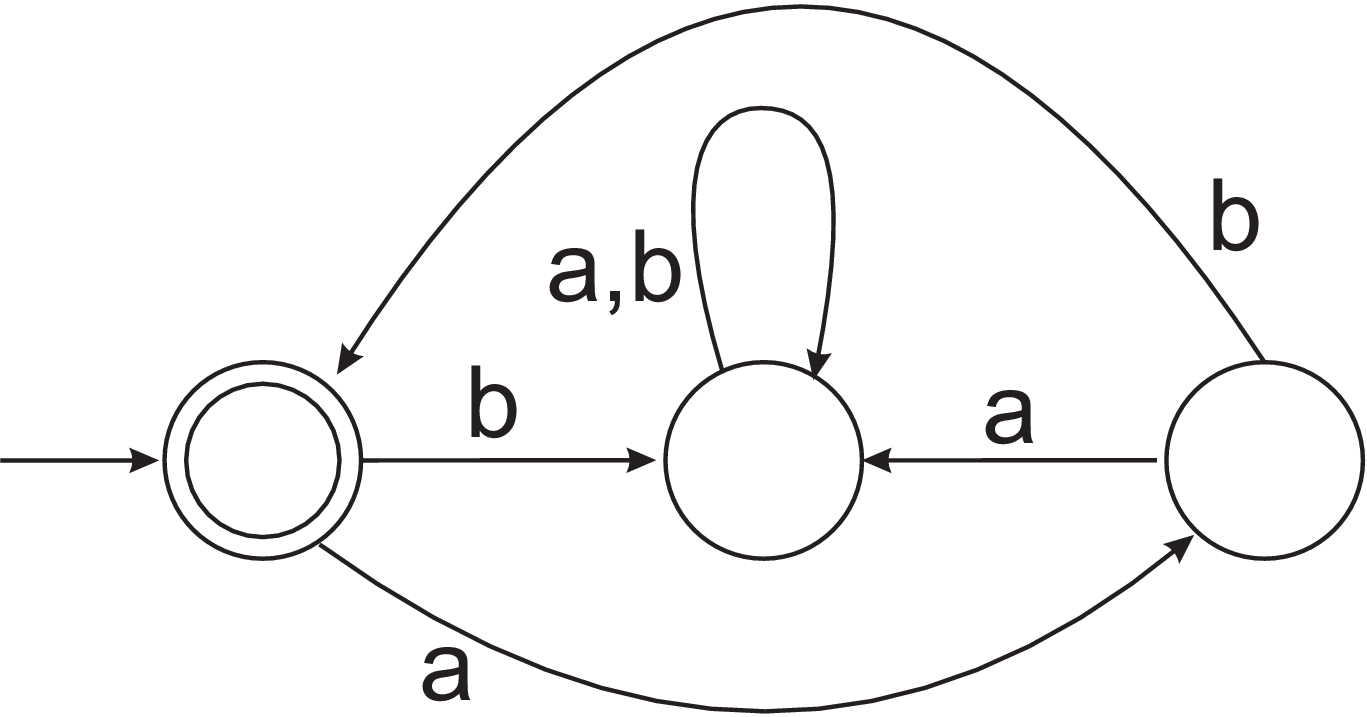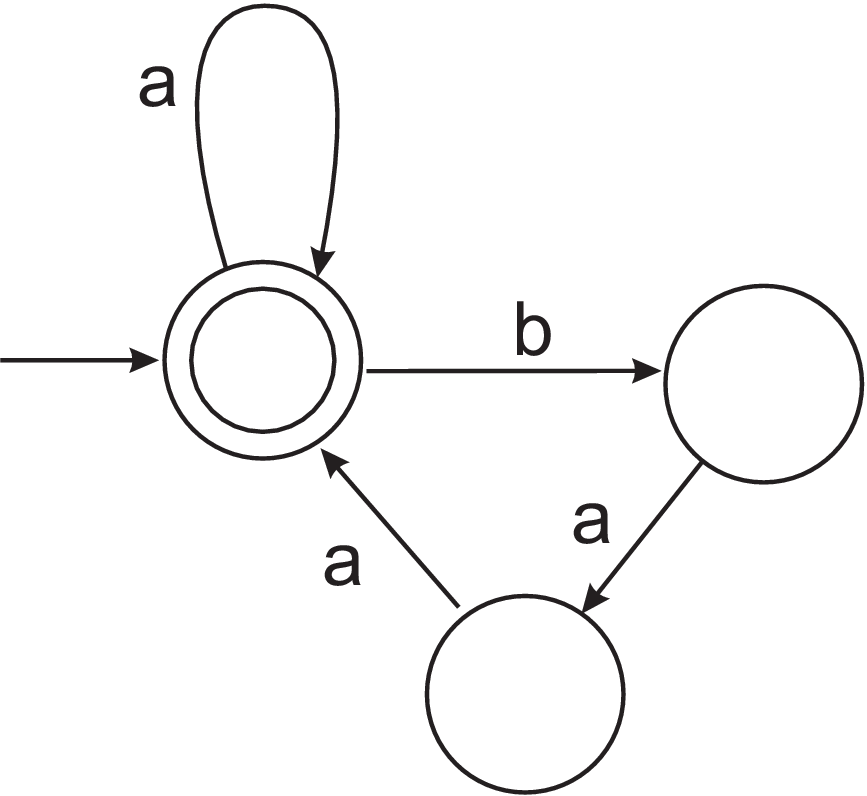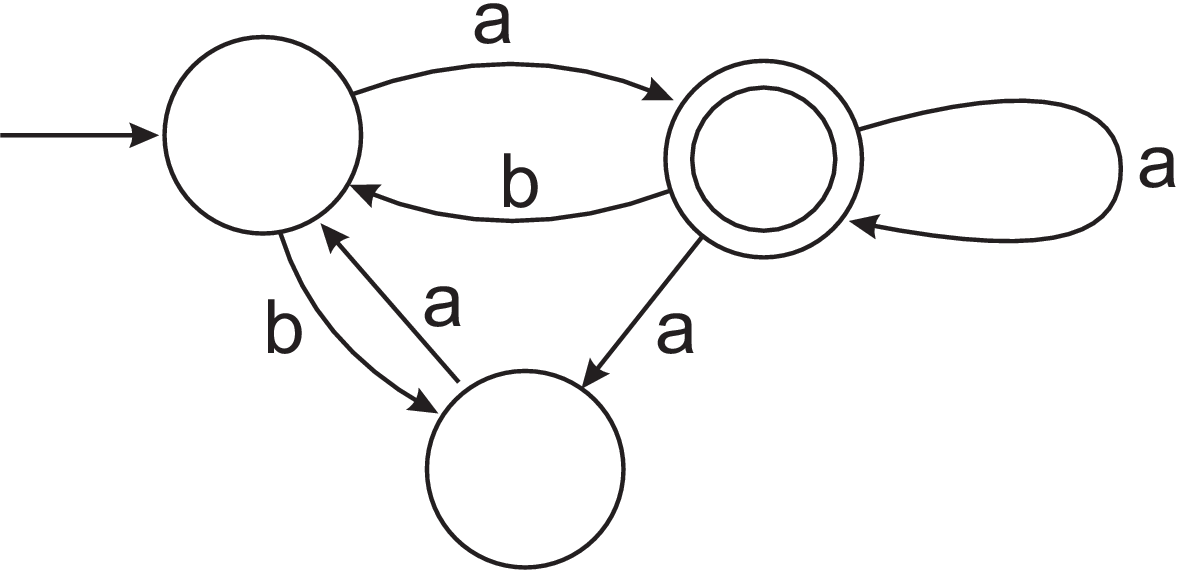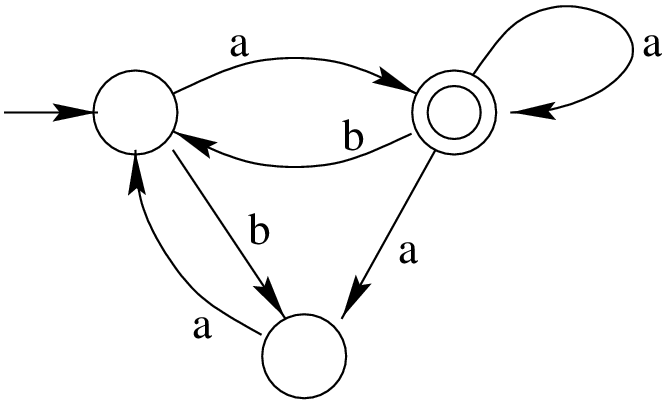Deadlines
- QI
- Sunday 22 January at 20:01 (Week 2).
- QII
- Sunday 29 January at 20:10 (Week 3).
- QIII
- Sunday 5 February at 20:11 (Week 3).
- QIV and QV
- Sunday 26 February at 20:19 (Week 7).
Note that these questions contribute to your final exam mark. After writing answers to these questions, please e-mail your answers to:
- Pierre Le Bras (pl196).
Please make the subject header be precisely F29LP Exercises. Submissions must be in pdf format and have a filename ending with .pdf (too many formatting problems with other file formats, including even .txt; think Mac vs Windows vs Linux encodings of linebreaks).
Brownie points may be awarded for correctly stating the significance (to me) of the times of day of the deadlines.
Question I: regexes
Notes on answering this question: In my experience the most convincing presentation for your answers is to cut-and-paste the text below, then just highlight the non-matching regexes in RED and the matching regexes in GREEN. So you end up with a pretty multicolour list of QandAs, and the marker just scans the page looking for the right pattern. You’re very welcome to write an English justification; this is not required by the question but may help the marker to understand your thinking and so give you feedback.
In the questions below, “matches” refers to whole-string matching (and not to matching a substring).
- Which of the following matches regex /
abababa/?
1)abababa
2)aaba
3)aabbaa
4)aba
5)aabababa - Which of the following matches regex /
ab+c?/?
1)abc
2)ac
3)abbb
4)bbc - Which of the following matches regex /
a.[bc]+/?
1)abc
2)abbbbbbbb
3)azc
4)abcbcbcbc
5)ac
6)asccbbbbcbcccc - Which of the following matches regex /
abc|xyz/?
1)abc
2)xyz
3)abc|xyz - Which of the following matches regex /
[a-z]+[\.\?!]/?
1)battle!
2)Hot
3)green
4)swamping.
5)jump up.
6)undulate?
7)is.? - Which of the following matches regex /
[a-zA-Z]*[^,]=/?
1)Butt=
2)BotHEr,=
3)Ample
4)FIdDlE7h=
5)Brittle =
6)Other.= - Which of the following matches regex /
[a-z][\.\?!]\s+[A-Z]/?
(\s matches any space character)
1)A. B
2)c! d
3)e f
4)g. H
5)i? J
6)k L - Which of the following matches regex /
(very )+(fat )?(tall|ugly) man/?
1)very fat man
2)fat tall man
3)very very fat ugly man
4)very very very tall man - Which of the following matches regex /
<[^>]+>/?
1)<an xml tag>
2)<opentag> <closetag>
3)</closetag>
4)<>
5)<with attribute=”77”> - Write a regex to identify dates of the form dd/mm/yyyy.
I expect dd to range from 01 to 31, and mm to range from 01 to 12, and I expect yyyy to range from 0001 to 9999 and in particular to not be 0000 (the Gregorian calendar predates this; see Year 0 and the invention of 0).
However, I do not expect you to cross-reference mm against dd or to restrict yyyy, so that e.g. 31/02/0231 is fine.
Do not use backreferences or negative lookahead (so if your answer contains?!, then it’s not admissible for this question). - Write a regex to identify dates of the form dd/mm/yyyy or dd.mm.yyyy, but not using mixed separators such as dd/mm.yyyy.
You may use backreferences, negative lookahead, and other fancy tricks, if convenient. - (Unmarked) Explain whether a regex can identify correct bracketing, as in
((a))but not(((a). - (Unmarked) Explain the relevance of the regex /
Whiske?y/ - Write a regex for the set of even numbers (base 10; so the alphabet is
[0-9]). Note that 0 is an even number and 00 and 02 are not even numbers. Check your regex accepts 100 and 10012.
Question II: Grammars
Notes on answering this question:
- Pay attention to what kind of grammer I ask for (regular, or context free, or some other type).
- For instance: if I ask for a regular grammar and you give me some other kind of grammer, then you may lose marks!
- Always clearly specify the start symbol.
- The alphabet (set of tokens) of a language cannot contain ε. ε is the empty string, that is, an absence of tokens. If your answer contains something of the form T={ε,…} (where T is supposed to be a set of tokens for your language) — then your answer is probably wrong and you’re probably losing marks.
Some of you have not met sets notation before, so here’s a quick tutorial:
- The language determined by the regex /a*/ is { aⁿ | n ∈ ℕ} or equivalently { aⁿ | n ∈ {0,1,2,…} } or equivalently { aⁿ | n ≥ 0 }.
- The language determined by the regex /(a|b)?/ is { a, b, ε }.
- The language determined by the regex /a+b+/ is { aᵐbⁿ | m,n ≥ 1 } or equivalently { aᵐbⁿ | m ≥ 1, n ≥ 1 } or equivalently { aᵐbⁿ | m,n ∈ {1,2,3,…} }.
- The language determined by the English description “any nonzero digit” is { 1, 2, 3, 4, 5, 6, 7, 8, 9} or equivalently { 1, 2, … , 9} or equivalently { n | 9 ≥ n ≥ 1 } or equivalently { n | 0 < n ≤ 9 }.
Now on to the questions:
- Write the language determined by the regex /
a*b*/ - Write a regular grammar to generate the language determined by the regex /
a*b*/ - Write the language determined by the regex /
(ab)*/ - Write a regular grammar to generate the language determined by the regex /
(ab)*/ - Write the language determined by /
Whiske?y/. The alphabet is {W,h,i,s,k,e,y} (W is a terminal symbol here). - Write a regular grammar to generate the language matched by /
Whiske?y/ - Write a regular grammar to generate decimal numbers; the relevant regex is /
[1-9][0-9]*(\.[0-9]*[1-9])?/.
You may find it useful to use notation resembling D ::= 0 | 1 | … | 9 to denote an evident set of ten production rules. - Give a context free grammar for the language L = { aⁿ bⁿ | n ∈ ℕ}.
- Give a context free grammar for the set of properly bracketed sentences over alphabet {
0,(,)}. So0and((0))are fine, and00and0)are not fine. - Write a context free grammar to generate possibly bracketed expressions of arithmetic with + and * and single digit numbers. So
0and(0)and0+1+2and(0+9)are fine, and(0+)1and12are not fine. - Give a grammar for palindromes over the alphabet {
a,b}. - A parity-sequence is a sequence consisting of 0s and 1s that has an even number of ones. Give a grammar for parity-sequences.
- Write a grammar for the set of numbers divisible by 4 (base 10; so the alphabet is
[0-9]). You might like to read this page on divisibility testing, first. You may use dots notation to represent an evident sequence, as in for example the sequence $Z3,Z6,Z9,\dots,Z999$ to mean “Z followed by some number divisible by three and strictly between 0 and 1000”. - Write a grammar for the set of numbers divisible by 3 (base 10; so the alphabet is
[0-9]). So for example0,003, and120should be in your language, and1,2, and5should not. - (Unmarked) Write a grammar for the set of numbers divisible by 11 (base 10; so the alphabet is
[0-9]).
Question III: More on grammars
- State which of the following production rules are left-regular, right-regular, left-recursive, right-recursive, context-free (or more than one, or none, of these):
- $\mbox{Thsi} \longrightarrow \mbox{This}\ $ (a rewrite auto-applied by Microsoft Word).
- \(\mbox{Sentence} \longrightarrow \mbox{Subject Verb Object}\). (Here Sentence, Subject, Verb, and Object are non-terminal symbols.)
- $X \longrightarrow Xa$.
- $X \longrightarrow XaX$.
- What is the object language generated by $X \longrightarrow Xa$ (see lecture 2)? Explain your answer.
- Construct context-free grammars that generate the following languages:
- $(ab|ba)^*$,
- $\{(ab)^na^n\ |\ n\geq 1\}$,
- $\{w\in\{a,b\}^*\ |\ \mbox{ $w$ is a palindrome }\}$,
- $\{w\in\{a,b\}^*\ |\ \mbox{ $w$ contains exactly two $b$s and any number of $a$s }\}$,
- $\{a^nb^m\ |\ 0\leq n\leq m\leq 2n \}$.
- Consider the grammar $G=(\{S,A,B\}, \{a,b\}, P, S)$ with productions
$$
\begin{array}{lcl}
S & \longrightarrow & S{}A{}B\ |\ \varepsilon\\
A & \longrightarrow & aA\ |\ \varepsilon\\
B & \longrightarrow & Bb\ |\ \varepsilon
\end{array}
$$- Give a leftmost derivation for $aababba$.
- Draw the derivation tree corresponding to your derivation.
- State with proof whether the following grammars are ambiguous or unambiguous:
- $G=(\{S\}, \{a,b\}, P, S)$ with productions $S \longrightarrow aSa\ |\ aSbSa\ |\ \varepsilon$.
- $G=(\{S\}, \{a,b\}, P, S)$ with productions $S \longrightarrow aaSb\ |\ abSbS\ |\ \varepsilon$.
- Rewrite the following grammar to eliminate left-recursion:
$$
exp \longrightarrow exp + term \mid exp\ -\ term \mid term .
$$ - Write a grammar to parse arithmetic expressions (with $+$ and $\times$) on integers (such as $0$, $42$, $-1$). This is a little harder than it first sounds because you will need to write a grammar to generate correctly-formatted positive and negative numbers; a grammar that generates $-01$ is unacceptable. You may use dots notation to indicate obvious replication of rules, as in “$D \longrightarrow 0 \mid \dots \mid 9$”, without comment.
- Write two distinct parse trees for $2+3*4$ and explain in intuitive terms the significance of the two different parsings to their denotation.
Question IV: DFAs and NFAs
You may find draw.io useful for drawing automata. If you know of a similar and better tool, please let me know.
- By writing a regular expression or a grammar, describe the language accepted by the DFA

- By writing a regular expression or a grammar, describe the language accepted by the DFA

- Construct NFAs (possibly with $\epsilon$-moves) to recognise the languages on alphabet {a,b} such that:
- $L=\{w\in\{a,b\}^*\ |\ \mbox{ $w$ contains at most two $a$’s }\}$
- $L=\{w\in\{a,b\}^*\ |\ \mbox{ $w$ contains an even number of occurrences of $ab$ as a subword }\}$
- $L=\{w\in\{a,b\}^*\ |\ \mbox{ the first and the last letter of $w$ are identical }\}$
- By writing a regular expression or a grammar, describe the language accepted by the NFA

- By writing a regular expression or a grammar, describe the language accepted by the NFA

- (Unmarked) Use the powerset construction (see lecture 5) to construct a DFA that recognises the same language as the following NFA:

- (Hard) Let $L$ be the language recognised by the NFA

- Construct a context-free grammar $G$ that generates language $L$.
- State with proof whether $G$ is ambiguous or unambiguous.
- (Unmarked) Let $G=(\{S,A,B\},\{a,b\},P,S)$ be the context-free grammar with productions
$$
\begin{array}{lcl}
S & \longrightarrow & aAbS\ |\ bBaS\ |\ \varepsilon,\\
A & \longrightarrow & aAbA\ |\ \varepsilon,\\
B & \longrightarrow & bBaB\ |\ \varepsilon.
\end{array}
$$
Give a short and intuitive English description of the language determined by $G$ (such a description does exist).
Question V: PDAs
In the questions below, assume the alphabet is $\{a,b\}$. Your answer must state the acceptance mode used.
- Describe a pushdown automaton that recognises \(\{a^m b^n a^m \mid m,n\geq 0 \}\).
- Assume \(m,n\geq 0\). Describe a DFA that recognises \(\{a^m b^n a^m \}\).
Explain why this question is different from the previous question. - Describe a pushdown automaton that recognises \(\{a^m b^{2n}\mid m,n\geq 0 \}\).
- Describe a pushdown automaton that recognises \(\{a^m b^n\mid m> n > 0 \}\).
- Describe a pushdown automaton that recognises \(\{ w \mid {\#{}_a} w={\#{}_b} w \}\),
where \(\#{}_a w\) is the number of $a$s appearing in $w$ and \(\#{}_b w\) is the number of $b$s appearing in $w$. - Describe a pushdown automaton that recognises \(\{ w \mid \#{}_a w=2\#{}_b w \}\).
- Describe a pushdown automaton that recognises \(\{ w \mid \#{}_a w\neq \#{}_b w \}\).
Some exercises based on these notes.